Geotimes

Untitled Document

Travels in Geology
August 2005
Stone sleuthing in Rousse,
Bulgaria
Edward Monroe
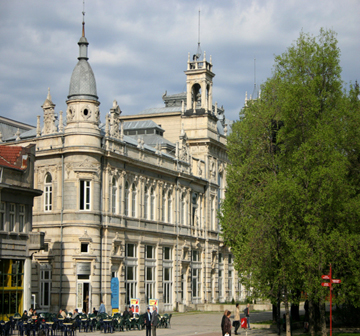 With
its entry into the European Union expected in 2007, Bulgaria is fast becoming
a hot tourist destination. Just two to three hours by air from cities like London
and Tel Aviv, many visitors come for the Black Sea coastline, the ski resorts
and the spa centers. Bulgaria's best-kept secrets, however, are its historical
stone buildings, some more than 2,500 years of age.
With
its entry into the European Union expected in 2007, Bulgaria is fast becoming
a hot tourist destination. Just two to three hours by air from cities like London
and Tel Aviv, many visitors come for the Black Sea coastline, the ski resorts
and the spa centers. Bulgaria's best-kept secrets, however, are its historical
stone buildings, some more than 2,500 years of age.
I recently explored the port city of Rousse, located in northeastern Bulgaria
along the Danube River. There, I discovered the use of local limestone in the
construction of a Roman fortress, an Ottoman wall, Bulgarian churches and a
late 19th-century public building.
The theater building in Rousse, Bulgaria,
is carved from local limestone that can appear light pink in bright sunlight.
People have been using the local stone in construction since Roman times. Bulgaria
is becoming a hot tourist spot, but Rousse is still quieter than other places.
All images courtesy of Edward Monroe.
The local building blocks of Rousse come from the Roussenska Formation, which
consists of limestone formed in a shallow sea during the early Mesozoic Era,
approximately 100 million years ago. Later, uplifting occurred, from the Pliocene
to Pleistocene epochs. Over millions of years, as the Roussenski Lom River flowed
to the Danube, it eroded the local limestone, producing cliffs up to 100 meters
high.
Roussenski limestone is light, strong, soft, and readily available along cliff
faces, making it an attractive building material. Generally a white to cream
color, it can appear light pink in bright sunlight. The presence of iron oxide
produces a red-brown color that creates an appearance of light brush strokes
through the stone.
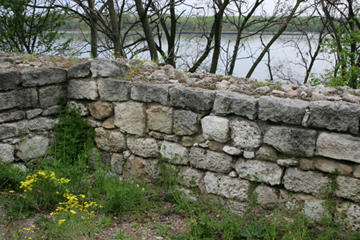 Roussenski
limestone has been quarried for centuries near the villages of Ivanovo, Basarbovo,
Krasen and Pirgovo. Today, the best way to see the limestone is by touring the
beautiful Rousse area, located on the Danube River, a historical passageway
that extends 2,850 kilometers from the Black Forest region of Germany to the
Black Sea. The Danube River was once a shifting border of the Roman Empire,
and the military established posts along the waterway.
Roussenski
limestone has been quarried for centuries near the villages of Ivanovo, Basarbovo,
Krasen and Pirgovo. Today, the best way to see the limestone is by touring the
beautiful Rousse area, located on the Danube River, a historical passageway
that extends 2,850 kilometers from the Black Forest region of Germany to the
Black Sea. The Danube River was once a shifting border of the Roman Empire,
and the military established posts along the waterway.
Using the local limestone, the Ottomans
constructed a wall (at left) with five gates around Rousse; only one (below),
the Kyuntukapu gate, remains.
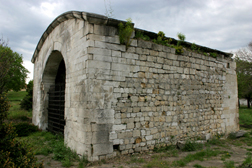 A key
stop along your tour of present-day Rousse's limestone buildings is the naval
station known as Sexsaginta Prista, or "sixty ships," which was built
under Emperor Vespasianus in A.D. 69 to 79. In its construction, rough-hewn
limestone blocks were secured with mortar-containing sediments from the local
riverbeds. Eventually, Avar and Slav raids destroyed the fortification in the
7th century. Today, archaeological work continues to reveal fortification walls,
baths, tombs and sarcophagi.
A key
stop along your tour of present-day Rousse's limestone buildings is the naval
station known as Sexsaginta Prista, or "sixty ships," which was built
under Emperor Vespasianus in A.D. 69 to 79. In its construction, rough-hewn
limestone blocks were secured with mortar-containing sediments from the local
riverbeds. Eventually, Avar and Slav raids destroyed the fortification in the
7th century. Today, archaeological work continues to reveal fortification walls,
baths, tombs and sarcophagi.
In the late 14th century, the Ottoman Empire defeated the second Bulgarian
Kingdom and would occupy the land for the next 500 years. Early on, the Ottomans
recognized the military and trade value of ports along the Danube River. They
referred to modern Rousse as "Rouschouk," and made it a busy center
of trade. Merchants from the cities of Dubrovnik, Venice and Genoa settled there.
During that time, a wall was constructed around the city with five gates named
Stambulkapia, Ortakapu, Kyulkapu, Kyuntukapu and Humba. Following the Russian-Turkish
War in 1878, Rouschouk was defortified, and the cut limestone blocks from the
wall were recycled for use in residential and public buildings. Today, the location
of the former wall is occupied by the city's inner ring road and park, but you
can still find the Kyuntukapu gate, the only one remaining .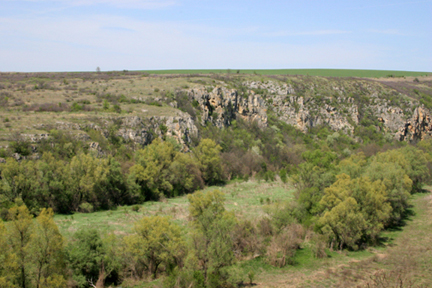
Travel about 22 kilometers southwest of Rousse, near the village of Ivanovo
in the Roussenski Lom Nature Park, to visit the Rock-hewn Churches of Ivanovo,
a UNESCO World Heritage Site. During the secondBulgarian Kingdom in the 12th
to 14th centuries, builders carved monastic chambers into solid limestone cliffs
40 meters from the base of the valley. The site is widely known for the quality
of paintings on the church walls. Monks created depictions of religious events
and figures, including Passion Week and the life of St. John the Baptist. Their
efforts drew the support of Bulgarian national political and religious leaders,
including Czar Ivan Alexander, who ruled from 1331 to 1371.
The Roussenski Lom Nature Park (at right),
just southwest of Rousse, is well-known for its rock-hewn churches that are
carved into the limestone cliffs. The churches are a UNESCO World Heritage Site.
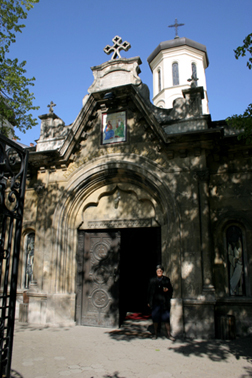 Once
back in the city, for a look at church construction from the 17th century, check
out Sveta Troista, the Eastern Orthodox Church constructed sometime between
1632 and 1638. Its construction reveals the challenges Bulgarian Christians
encountered in securing religious freedom. The original church was only 2 meters
wide and 9 meters long. While Ottoman regulations made it difficult to build
a new church, Christians were permitted to add on to existing churches. Additional
Ottoman regulations set a height limit. As a result, additions to the original
church were constructed with the main floor 4 meters below ground. Rows of windows
direct daylight to the center of the church. Following the liberation of Bulgaria
in 1878, a bell tower was added to the building. Many of the limestone blocks
that make up the exterior of the building have weathered to a dark gray color.
It is worth stopping by the icon museum in the upper portion of the church.
Once
back in the city, for a look at church construction from the 17th century, check
out Sveta Troista, the Eastern Orthodox Church constructed sometime between
1632 and 1638. Its construction reveals the challenges Bulgarian Christians
encountered in securing religious freedom. The original church was only 2 meters
wide and 9 meters long. While Ottoman regulations made it difficult to build
a new church, Christians were permitted to add on to existing churches. Additional
Ottoman regulations set a height limit. As a result, additions to the original
church were constructed with the main floor 4 meters below ground. Rows of windows
direct daylight to the center of the church. Following the liberation of Bulgaria
in 1878, a bell tower was added to the building. Many of the limestone blocks
that make up the exterior of the building have weathered to a dark gray color.
It is worth stopping by the icon museum in the upper portion of the church.
For more recent construction in Rousse,
the Sveta Troista, erected in the 1600s, highlights the struggles of Bulgarian
Christians of the time.
Rounding out a tour of Rousse's building stones is the Profit Yielding Building,
constructed from 1898 to 1902 as a trade center. The building, colloquially
referred to as the "theater building," is a blend of architectural
styles complete with a sculpture of the winged god of trade, Mercury. Inside
are stages of the Rousse drama theater where some of Bulgaria's most famous
actors and stage directors have performed. Roussenski limestone tiles form the
veneer of the building, as well as fine architectural details and sculptures.
Outside of Rousse, the value of the area's limestone can be seen in Bulgaria's
capital city, Sofia, and even in western European cities such as Vienna. Yet,
unlike more popular tourist destinations, Rousse remains a relaxing summer spot.
I recommend beginning any tour at Freedom Square, where accommodations are available
at the Danube Hotel across from the tourist information center. The pedestrian-only
central square is ideal for strolling, shopping, and restaurant hopping. Also,
consider walking through the parks along the Danube, and perhaps a cruise down
the river. Any visitor is sure to discover Rousse's unique charm.
Monroe is conducting research
in Bulgaria through a Fulbright Fellowship. His research project, entitled "Building
Stones of Bulgaria from Ancient Times to the Present," aims to create educational
materials to Bulgaria's unique historical stone monuments and buildings. E-mail:
edwardmonroejr04@fulbrightweb.org
Links:
Rousse
Municipality
Bulgarian
Geological Society
Destination
Bulgaria site
Travel
Bulgaria site
Other Bulgarian stone articles by the author:
Madara
Horseman
The
Rhodopi Village
Starosel-Chetinyova
Mogila
New
American Embassy in Bulgaria
Travels in Geology
Back to top
Untitled Document

 With
its entry into the European Union expected in 2007, Bulgaria is fast becoming
a hot tourist destination. Just two to three hours by air from cities like London
and Tel Aviv, many visitors come for the Black Sea coastline, the ski resorts
and the spa centers. Bulgaria's best-kept secrets, however, are its historical
stone buildings, some more than 2,500 years of age.
With
its entry into the European Union expected in 2007, Bulgaria is fast becoming
a hot tourist destination. Just two to three hours by air from cities like London
and Tel Aviv, many visitors come for the Black Sea coastline, the ski resorts
and the spa centers. Bulgaria's best-kept secrets, however, are its historical
stone buildings, some more than 2,500 years of age. 
 Roussenski
limestone has been quarried for centuries near the villages of Ivanovo, Basarbovo,
Krasen and Pirgovo. Today, the best way to see the limestone is by touring the
beautiful Rousse area, located on the Danube River, a historical passageway
that extends 2,850 kilometers from the Black Forest region of Germany to the
Black Sea. The Danube River was once a shifting border of the Roman Empire,
and the military established posts along the waterway.
Roussenski
limestone has been quarried for centuries near the villages of Ivanovo, Basarbovo,
Krasen and Pirgovo. Today, the best way to see the limestone is by touring the
beautiful Rousse area, located on the Danube River, a historical passageway
that extends 2,850 kilometers from the Black Forest region of Germany to the
Black Sea. The Danube River was once a shifting border of the Roman Empire,
and the military established posts along the waterway.  A key
stop along your tour of present-day Rousse's limestone buildings is the naval
station known as Sexsaginta Prista, or "sixty ships," which was built
under Emperor Vespasianus in A.D. 69 to 79. In its construction, rough-hewn
limestone blocks were secured with mortar-containing sediments from the local
riverbeds. Eventually, Avar and Slav raids destroyed the fortification in the
7th century. Today, archaeological work continues to reveal fortification walls,
baths, tombs and sarcophagi.
A key
stop along your tour of present-day Rousse's limestone buildings is the naval
station known as Sexsaginta Prista, or "sixty ships," which was built
under Emperor Vespasianus in A.D. 69 to 79. In its construction, rough-hewn
limestone blocks were secured with mortar-containing sediments from the local
riverbeds. Eventually, Avar and Slav raids destroyed the fortification in the
7th century. Today, archaeological work continues to reveal fortification walls,
baths, tombs and sarcophagi.
 Once
back in the city, for a look at church construction from the 17th century, check
out Sveta Troista, the Eastern Orthodox Church constructed sometime between
1632 and 1638. Its construction reveals the challenges Bulgarian Christians
encountered in securing religious freedom. The original church was only 2 meters
wide and 9 meters long. While Ottoman regulations made it difficult to build
a new church, Christians were permitted to add on to existing churches. Additional
Ottoman regulations set a height limit. As a result, additions to the original
church were constructed with the main floor 4 meters below ground. Rows of windows
direct daylight to the center of the church. Following the liberation of Bulgaria
in 1878, a bell tower was added to the building. Many of the limestone blocks
that make up the exterior of the building have weathered to a dark gray color.
It is worth stopping by the icon museum in the upper portion of the church.
Once
back in the city, for a look at church construction from the 17th century, check
out Sveta Troista, the Eastern Orthodox Church constructed sometime between
1632 and 1638. Its construction reveals the challenges Bulgarian Christians
encountered in securing religious freedom. The original church was only 2 meters
wide and 9 meters long. While Ottoman regulations made it difficult to build
a new church, Christians were permitted to add on to existing churches. Additional
Ottoman regulations set a height limit. As a result, additions to the original
church were constructed with the main floor 4 meters below ground. Rows of windows
direct daylight to the center of the church. Following the liberation of Bulgaria
in 1878, a bell tower was added to the building. Many of the limestone blocks
that make up the exterior of the building have weathered to a dark gray color.
It is worth stopping by the icon museum in the upper portion of the church.